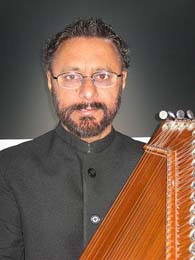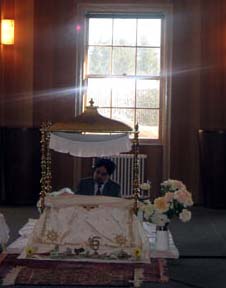
The Sanctuary Room in the Old Union Building at Stanford University, Palo Alto, echoed the sounds of Raag Basant, rendered by Kuldip Singh. He performed the Keertan in the presence of the Eternal Guru, the Sri Guru Granth Sahib commemorating its 300thanniversary.
The Keertan Darbar was organized by “Satrang” (Sikh Students Association of Stanford) and culminated in the sharing of “Guru ka Langar”, which was prepared by the local sangat.
Basant is a very old raga dating from the 8th century. The name Basant is from Sanskrit vasant meaning spring, and during that season of the year Basant may be performed at any time of the day or night. Otherwise, it is reserved for the night between 9 p.m. and midnight. This raga is mentioned as a son of raga Hindol in the Ragamala listed at the end of Guru Granth Sahib.
Guru Nanak, Guru Amar Das, Guru Ram Das, Guru Arjan and Guru Tegh Bahadur composed sabads to this raga. Performed in slow tempo, this gentle melody depicts quiet joy. The descending scale is usually found at the beginning of a composition with the ascending form following later. 
There are many variations of this raga. It is believed that the Basant raga recorded in Guru Granth Sahib is in its original and true variation. According to a tradition this raga is sung in the Sikh Gurdwaras from the festival of Magi to the festival of Hola Mohalla. The Sikh ragis start the singing of this raga on the first of the month of Mag,. They sing five shabads of the raga and then sing the 'var' of Basant and declare that they have opened the raga Basant. On the day of Holla Mohalla they sing the shabad 'surah ki jaisi teri chaal.._' (Bhagat Kabair page 1196) and end the singing of the raga.
Raags conveys a feeling and Shabad a message. the Gurus used Raags to increase delivery power of shabad to our mind by invoking complementary feelings in our hearts .A Raag is capable of touching the hearts with the feeling like joy, sorrow, detachment, etc.
Within the rules of Hindustani Classical Music, uncountable Raags can be created. In fact any form of music (non-Indian and non-classical) can be classified under some form of Raag. Hence it is a misconception that Raags are something highly classical and beyond the realms of common mans understanding. In-fact any form of music is Raag. But in Guru Granth Sahib, the Gurus have gone into depths of poetry, music and metrical forms to lay the framework that is best suited to convey the feeling and message of the Shabad simultaneously to the human mind and heart.
Stanford Keertan Darbar Reverberates Raag Basant. Watch/Listen online!
 Click for Video Part 1  Click for Video Part 2
 Basant, Third Mehla: Basant, Third Mehla:
Spring has come, and all the plants are flowering.
These beings and creatures blossom forth when they focus their consciousness on the Lord.
In this way, this mind is rejuvenated.
Chanting the Name of the Lord, Har, Har, day and night, egotism is removed and washed away from the Gurmukhs.
The True Guru speaks the Bani of the Word, and the Shabad, the Word of God.
This world blossoms forth in its greenery, through the love of the True Guru.
The mortal blossoms forth in flower and fruit, when the Lord Himself so wills.
He is attached to the Lord, the Primal Root of all, when he finds the True Guru.
The Lord Himself is the season of spring; the whole world is His Garden.
O Nanak, this most unique devotional worship comes only by perfect destiny.
|
|
BASANT, THIRD MEHL:
One who worships the Lord within his mind,
sees the One and Only Lord, and no other.
People in duality suffer terrible pain.
The True Guru has shown me the One Lord.
My God is in bloom, forever in spring.
This mind blossoms forth,
singing the Glorious Praises of
the Lord of the Universe.


Feeling communicated by
the music of Raag
1. Soohi – Joy & Separation
2. Bilaaval - happiness
3. Gaund - strangeness, surprise, beauty
4. Sri - satisfaction and balance
5. Maajh - loss, beautification
6. Gauri - Seriousness
7. Aasa - making effort
8. Gujri - satisfaction, softness of heart, sadness
9. Devgandhari - No specific feeling but the Raag has a softness
10. Bihaagra - beautification
11. Sorarth - motivation
12. Dhanasari - inspiration, motivation
13. Jaitsree - Softness, satisfaction, sadness
14, Todi - this being a flexible Raag it is apt for communicating many feelings
15. Bhairagi - sadness, (Gurus have however used it for the message of Bhakti)
16. Tilang - this is a favourite Raag of Muslims. It denotes feeling of beautification and yearning.
17. Raamkali - calmness
18. Nat Narayan - Happiness
19. Maali Gaura - Happiness
20. Maaru - giving up of Cowardice
21. Tukhari - beautification
22. Kedara - Love and beautification
23. Bhairav - Seriousness, brings stability of mind
24. Basant - happiness
25. Sarang - sadness
26. Malar - seperation
27. Jaijawanti - Virag
28. Kalyan - Bhakti Ras
29. Vadhans - Vairag, Loss (that is why Alahniya is sung in this Raag when someone passes away)
30. Parbhati - Bhakti and seriousness
31. Kanra - Bhakti and seriousness
|

